Are you a Quiet Speculation member?
If not, now is a perfect time to join up! Our powerful tools, breaking-news analysis, and exclusive Discord channel will make sure you stay up to date and ahead of the curve.
I'm preparing for an RPTQ, but it's hard to stop brewing. Whipping up decklists full of pet cards is just too fun. Even when those pet cards are literal pieces of trash. Ross Merriam's recent Legacy article reminded me of one pet card I'd long forgotten, four copies languishing in my Modern collection with the other rejects. I don't expect to break the format with this project—when I build around fair cards, I never do. My goal this week was simply to find the best possible shell for a playset of Ninja of the Deep Hours.
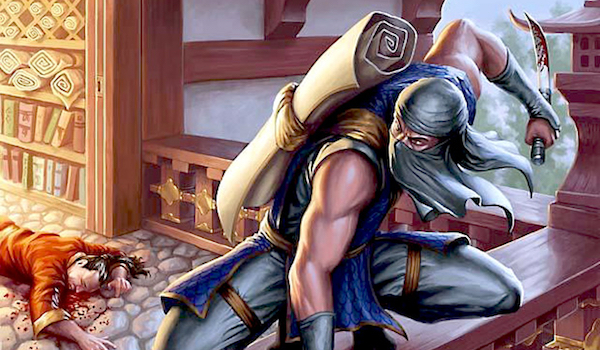
Two Ways to Brew
Brewing is a lot like eating a Reese's cup—there's no wrong way. Still, I've identified two primary methods of brewing since I began: around concepts and around cards.
[wp_ad_camp_1]
Brewing Around Concepts
 Conceptual brewing is the most common form when it comes to high-level Modern. Competitive players seek to attack the format a certain way, or to exploit an identified soft spot in the metagame, and create decks that do so. Since the question, "How can I effectively attack the metagame?" is one anyone looking to spike a Modern event is bound to ask themselves, it's no wonder that conceptual brewing spawns so many winning decks.
Conceptual brewing is the most common form when it comes to high-level Modern. Competitive players seek to attack the format a certain way, or to exploit an identified soft spot in the metagame, and create decks that do so. Since the question, "How can I effectively attack the metagame?" is one anyone looking to spike a Modern event is bound to ask themselves, it's no wonder that conceptual brewing spawns so many winning decks.
With an idea in mind, crafting a list becomes easy. After that, testing hopefully indicates if there's a better way to represent that idea in 75 cards or whether the idea was worthwhile to begin with. Death's Shadow Aggro with more interaction? Death's Shadow Blue. (Not worth it.) A delve-abusing Temur Delver deck in a Treasure Cruise-less world? Monkey Grow. (Worth it.) Early lock pieces and cheated-out threats? Colorless Eldrazi Stompy. (The jury's still out on this one.) These three are just examples that I've worked on, but conceptual brewing abounds in Modern.
GP Charlotte 2015 featured a Top 16 that exemplified this principle. Michael Malone exploited the absence of red sweepers to take the tournament with Elves. Zach Jesse also cracked the Top 8 with Bob Huang's Grishoalbrand, which preyed on the Grixis Control-heavy metagame's lack of efficient graveyard hate, cheap counterspells, and Path to Exile.
Coming in at 9th place, Patrick Chapin employed the untapped potential of Fate Reforged's under-costed fatties to concoct a delve-heavy build of Grixis Control that went on to define the coming summer. Zac Elsik joined Chapin in the Top 16 with Lantern Control, a deck that had Grafdigger's Cage and Surgical Extraction to answer everyone's favorite artifact removal spell, Ancient Grudge, and locked up games with the at-the-time unanswerable Ensnaring Bridge.
These diverse decks have something in common: their creators followed one idea to its logical conclusion and ended up contributing one more deck to Modern's vast roster.
Brewing Around Cards
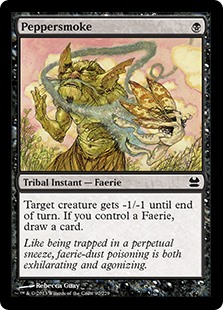 The second method of brewing is largely utilized by casual players (even if many pros have a pet card too). Building around cards is what led me to the Thieves' Fortune-highlighting Temur Rogues, the Blood Moon and Goyf slumber party of GRx Moon, the Peppermoke vanity project Sultai Faeries, and a slew of Mantis Rider decks. It's rare that decks built around a single card break into the competitive scene. Successful examples include Living End, Restore Balance, and Ninja Bear Delver (which, despite boasting three other card names in its title, revolves around Disrupting Shoal).
The second method of brewing is largely utilized by casual players (even if many pros have a pet card too). Building around cards is what led me to the Thieves' Fortune-highlighting Temur Rogues, the Blood Moon and Goyf slumber party of GRx Moon, the Peppermoke vanity project Sultai Faeries, and a slew of Mantis Rider decks. It's rare that decks built around a single card break into the competitive scene. Successful examples include Living End, Restore Balance, and Ninja Bear Delver (which, despite boasting three other card names in its title, revolves around Disrupting Shoal).
In a format with stand-alone goodstuff cards the likes of Tarmogoyf and Lightning Bolt, card-focused brews are routinely combo-oriented. Deckbuilders see a unique card like Ad Nauseam, dream up its most degenerate applications, and tinker around with lists until someone Top 8s an event and ends up writing history (or doesn't, and doesn't). But building around a fair card generally yields worse results than simply playing fair cards that excel individually. This depressing truism explains why my own card-focused brews, all of them as fair as first snow, never performed as I'd wished.
Consider the Ninja
To play bad cards in Modern, we must first understand what makes those cards so bad. So must we examine Ninja of the Deep Hours.
Failing the Bolt Test
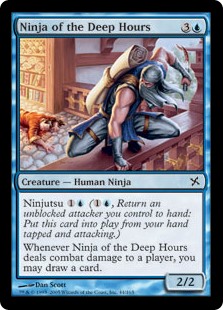 One reason is his toughness. At 2/2, Ninja's stats plant him firmly in the "dies to Lightning Bolt" camp of Modern deplorables. Creatures in Modern with less than three toughness need to fulfill certain conditions to succeed. Most of them simply break parity with the instant, either by costing one (Goblin Guide, Signal Pest) or by making Bolt cost more than one (Thalia, Guardian of Thraben).
One reason is his toughness. At 2/2, Ninja's stats plant him firmly in the "dies to Lightning Bolt" camp of Modern deplorables. Creatures in Modern with less than three toughness need to fulfill certain conditions to succeed. Most of them simply break parity with the instant, either by costing one (Goblin Guide, Signal Pest) or by making Bolt cost more than one (Thalia, Guardian of Thraben).
Boltable creatures that check neither box must either offer a strategy tremendous synergy (i.e. Leonin Arbiter, Lord of Atlantis), cast a spell upon entering the battlefield (Eternal Witness, Sin Collector), or take over the game when left unanswered (Dark Confidant). So how does Ninja of the Deep Hours stack up against these requirements?
We're looking to specifically build around Ninja of the Deep Hours, so let's bench the synergy criterion for now and assume the card will work in our deck. Ninja sort of casts a spell when he enters the battlefield, but opponents can't kill him after he tags in, and he necessitates an unblocked attacker to lay out the red carpet. "Draw a card" hardly even constitutes a full spell, since it's a line of text shared by many two-drops (Wall of Omens, Silvergill Adept), and Ninja of the Deep Hours is functionally a three-drop. Unfortunately, these factors make Ninja's "spell" too conditional to count, despite its potential renewability.
As for winning the game unchecked, Ninja certainly does that, especially in a deck full of high-powered cards. Dark Confidant is a format staple, but there's a reason we never see Goblin Rabblemaster or Geist of Saint Traft take down Opens. Three-drops that win the game unchecked aren't fast enough for Modern. Factoring in both the cost of ninjutsu and the price of a bounced attacker, Ninja of the Deep Hours stands to charge us three mana even when snuck in, so he's not eligible for this criterion, either.
Losing Us Tempo
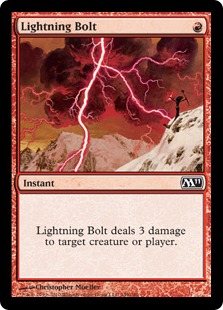 Format newcomers often ask, "so what if Card X dies to Bolt? It's still a good card." But it's usually not still a good card. Failing the Bolt Test is such a big deal because it incurs a tempo loss. Despite crushing from a flavor perspective, the ninjutsu keyword sets users back drastically on this misunderstood mechanic.
Format newcomers often ask, "so what if Card X dies to Bolt? It's still a good card." But it's usually not still a good card. Failing the Bolt Test is such a big deal because it incurs a tempo loss. Despite crushing from a flavor perspective, the ninjutsu keyword sets users back drastically on this misunderstood mechanic.
Modern in particular rewards players for capitalizing on tempo advantages and disregarding card advantage. Trading three or more mana for an opponent's one is an easy way to lose games here. On top of all that, Ninja takes our tempo and offers us card advantage in return. In Modern, we want to cash out the opposite way!
Deep Hour Accommodations
With all Ninja's shortcomings in the foreground, we can begin to address them head-on. Luckily for us meatheads, there are a few ways to cheat on the Bolt Test.
One technique is to play Mutagenic Growth, a card that acts as Mental Misstep against the ubiquitous instant. I've enjoyed this strategy in Counter-Cat, and others, led by Jeff Hoogland, have applied it to Jeskai Aggro strategies to render Mantis Rider a playable Modern card. Perhaps more famously, Death's Shadow Aggro and UR Prowess use Mutagenic Growth to push through extra damage with prowess threats, turn on synergies with Thing in the Ice, and of course save Wild Nacatl or Kiln Fiend from Lightning Bolt. It should be noted here that Swiftspear and Nacatl already pass the Bolt Test, so saving them with Growth is just gravy.
Another solution is to lure out an opponent's Bolts elsewhere. Leading with Noble Hierarch almost guarantees opponents will spend their Lightning Bolt if they're holding one, clearing the way for Ninja of the Deep Hours and other fragile threats. A common pitfall to avoid with this strategy is going "too wide," which opens us to blowouts from Anger of the Gods. The idea here is to go wider than an opponent's Bolts, but not wide enough to be crippled by sweepers. In many games, walking this line is a simple matter of not overcommitting threats to the board.
Since Ninja requires us to jump through so many hoops, each of my takes on the Ninja deck combined both approaches.
Version One: Monkeying Around
 I considered trying a straight blue-red shell, but soon came to my senses and realized I wanted Tarmogoyf. Goyf is another way around the Bolt Test, especially in a deck that wants to distract an opponent's Bolts with decoy targets. When one of those creatures hits the bin, nothing cleans up the mess like our favorite fatty.
I considered trying a straight blue-red shell, but soon came to my senses and realized I wanted Tarmogoyf. Goyf is another way around the Bolt Test, especially in a deck that wants to distract an opponent's Bolts with decoy targets. When one of those creatures hits the bin, nothing cleans up the mess like our favorite fatty.
In this version, green gave us Noble Hierarch, which improves an active Ninja drastically in multiples, and Kird Ape, an aggressive one-drop that can be saved by Mutagenic Growth. Having savable attackers is paramount to this strategy once opponents figure out our plan, since they can just Bolt our attacker before blocks if they anticipate ninjutsu plus Mutagenic Growth and deny us the opportunity to even sub Ninja in.
I still wanted Noble Hierarch in this build, since she attacks past 1/1s on her own to enable ninjutsu if necessary. The acceleration she provides allows us to get more out of Spellstutter Sprite and Snapcaster Mage, enters-the-battlefield creatures that grant us additional value just by helping pay for ninjutsu. The former happens to be stellar at stopping Path to Exile and Lightning Bolt, and the latter allows us to re-use our valuable instants and transition to a reach plan if necessary.
Temur Ninja 1.0, by Jordan Boisvert
I often start my brews by throwing 60 cards together and adjusting for what I need as the games fly by, but this first draft was particularly atrocious.
For one, it durdled too much. I could beat Burn thanks to Tarmogoyf and Spellstutter Sprite, but victories against Tron proved far out of reach, even after sideboarding. Besides slowing us way down and taking forever to kill opponents without a Ninja around, Spellstutter Sprite was often a crapshoot with no Mutavault to turn it into Spell Snare. Despite the format's speed, or perhaps because of it, many decks just didn't have that many one-drops to counter once Spellstutter came online.
Kird Ape proved lackluster too, if better than Sprite and Snap. Returning aggressive one-drops for ninjutsu and recasting them seemed far more reasonable than goofing around with 187s. I had tried Monastery Swiftspear in this slot, but with so few instants and sorceries, the creature performed even worse than Ape. Goblin Guide also let me down, as giving opponents lands before returning Guide for ninjutsu just felt wrong. I wanted to be the only one getting up on cards from my attacks. (It's a little embarrassing, but for posterity, I'll add that I played a few games with a build mashing all of these creatures into one pile and adding Atarka's Command. I'll let you guess how that turned out.)
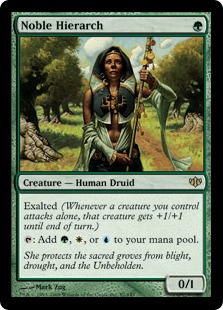 In the end, all three creatures seemed too inefficient to impress in this shell. They were at their best when they ate a Bolt and made way for Tarmogoyf. It's doesn't speak much to the competence of your creatures when you spend games hoping they die. Even Noble Hierarch fell short of my expectations. I habitually found myself wanting to attack with multiple bodies at a time, invalidating exalted, and flooding on mana despite only running 18 lands.
In the end, all three creatures seemed too inefficient to impress in this shell. They were at their best when they ate a Bolt and made way for Tarmogoyf. It's doesn't speak much to the competence of your creatures when you spend games hoping they die. Even Noble Hierarch fell short of my expectations. I habitually found myself wanting to attack with multiple bodies at a time, invalidating exalted, and flooding on mana despite only running 18 lands.
Another issue I had with this build is it didn't utilize the graveyard enough. I'm a big fan of squeezing every resource out of the game state. Without Hooting Mandrills, Grim Lavamancer, or something with the word "delirium," I often felt my graveyard was literally just a place where my used cards went. What is this, 1995? All the graveyard did was grow Tarmogoyf. If Prized Amalgam taught us anything this year, it's that we should expect more from our graveyards.
Some quick notes on the sideboard: Finks and Huntmaster came in against grindy and aggressive decks, and could both be bounced to ninjutsu for value (at the expense of much tempo). Spellskite added another way to dodge Lightning Bolt and hosed pump decks. Threads and Forked Bolt are just cute cards to kidnap Goyfs and kill Lingering Souls tokens, respectively.
The more impactful slots were Blood Moon, which stole many games on its own and helped against big-mana decks, and the Revelry/Grudge package, a necessity for dealing with Rest in Peace, Chalice of the Void, Ensaring Bridge, and other problematic permanents. Surgical Extraction was also integral to beating Dredge, although achieving that feat still required a fair amount of luck with this build.
The problems I experienced with each creature in the deck brewed a perfect storm of consistency complications, and I always seemed to have the wrong creatures handy for a given situation. I think this is an excusable problem for a first draft that jams a bunch of ideas together to see what happens, so long as deckbuilders learn from the brew's ineptitude and focus on honing its more successful undertakings in future builds.
Version Two: Gnarly, Dude
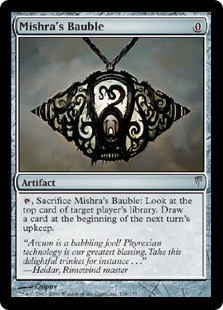 To my chagrin, there was no way to incorporate enough instants and sorceries to reliably cast Delver of Secrets as a ninjutsu enabler, not to mention how stupid I'd feel bouncing the transformed Insect to my hand. After spending some time longing for efficient one-drops I could save with Mutagenic Growth, Gnarlwood Dryad popped into my head, and I took the second version in the same direction as Delirium Zoo. Surf's up!
To my chagrin, there was no way to incorporate enough instants and sorceries to reliably cast Delver of Secrets as a ninjutsu enabler, not to mention how stupid I'd feel bouncing the transformed Insect to my hand. After spending some time longing for efficient one-drops I could save with Mutagenic Growth, Gnarlwood Dryad popped into my head, and I took the second version in the same direction as Delirium Zoo. Surf's up!
Gnarlwood put Kird Ape to shame. It became a 3/3 immediately if opponents chose to interact with me, and if not, I could drown them in cards with Ninja. Barring either scenario, weird card types like artifact and tribal could turn the Dryad into a clock early. Its deathtouch clause acted as pseudo-evasion, allowing it to easily tag out for Ninja when opponents didn't feel like losing a valuable creature. And with the new influx of card types, Monastery Swiftspear became playable, as this version went from 18 to 22 prowess triggerers.
I already wanted a total of six sorceries for Tarmogoyf, and they had to be easier to bin than Flame Slash if I also needed delirium. Traverse the Ulvenwald mostly made the cut here as a sure-fire way to find lands early. It still has obvious upside in a shell so focused on stocking the graveyard.
Delirium-mode Traverse usually grabbed Goyf for me, but it could also fetch utility via Snapcaster Mage, or Ninja when opponents had an open board. I think for Traverse the Ulvenwald to be splashable, decks must be able to make use of its Lay of the Land mode a good chunk of the time. Between Blood Moon in the board, prowess and delirium on our one-drops, and a miserly land drop, we can.
Temur Ninja 2.0, by Jordan Boisvert
This version felt much better, but ran into the same problems as my first build (albeit less often): it could clunk out on two-drops and sometimes lacked ways to enable early Ninjas. Generating extra value with ninjutsu and Snapcaster Mage never came up, and I lost plenty of games to nasty threats sticking on an opponent's field after mine had been destroyed.
Losing Sprite meant gaining access to Pyroclasm in the sideboard. I added Leak and Stroke to help against Tron, Ad Nauseam, and other big-spell decks. Between these cards, Moon, and my upgraded threat suite, these matchups became favorable. After testing Spellskite in the previous version, I switched to Dispel as my extra anti-removal measure of choice. Skite doesn't really attack, it doesn't really block, and it dies to Twisted Image. Additionally, we have game against Affinity and Infect just by virtue of our wedge. Nice card, just not for us.
Version Three: Ninjutzoo
My best games with the second version involved a triplicate of one-drops chased with Bauble and Probe. Ninja truly shone with these openers, since he always had a mate to come in for and was practically guaranteed to connect at least once with so many targets for opposing removal. 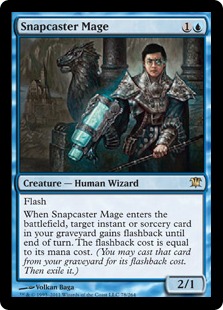 On the other hand, Snapcaster Mage disappointed me enormously. He conflicted with my aggro Plan A and wrestled with ninjutsu shenanigans for mana. I frequently wished Snap had been another one-drop.
On the other hand, Snapcaster Mage disappointed me enormously. He conflicted with my aggro Plan A and wrestled with ninjutsu shenanigans for mana. I frequently wished Snap had been another one-drop.
I thought about ditching Snap to add Kird Ape again, but decided to try splashing white first. Wild Nacatl is the greatest creature to ever meet a Mutagenic Growth, and I've been having a swell time testing for my upcoming RPTQ with that combination in Counter-Cat. Path to Exile also addressed the deck's other problem of struggling to overcome beefy threats, a shortcoming I feared would worsen without Snapcaster to reuse my Vapor Snags.
With fewer basic lands in the deck, more threats, and stricter mana requirements, Traverse the Ulvenwald became Gitaxian Probe. Probe also plays a little better with Swiftspear and makes sure the coast is clear for a Growth-less ninjutsu attack.
I mostly cribbed the manabase from Counter-Cat. Since we use so much green and red we may also want Breeding Pool and Sacred Foundry in the mix somewhere, although that combination complicates the Lightning Helix package in the sideboard.
That said, Destructive Revelry can't be cast off Hallowed Fountain and Stomping Ground. I think this quirk presents less of an issue because we'll be harder-pressed to find answers to aggressive creatures than to aggressive artifacts and enchantments in Modern. We also prefer to fetch Steam Vents and Temple Garden in this deck to have red and green on separate lands, making Revelry easier to cast generally. Finally, casting Wild Nacatl off a Breeding Pool doesn't allow us the opportunity to save him from Lightning Bolt with Mutagenic Growth, which may be the nail in the coffin for the Pool/Foundry combo.
The sideboard set of Helix mitigates the life loss concurrent with aggressive fetch-shocking. Although we can't really run Blood Moon ourselves on four colors, we're surprisingly resilient to the enchantment. All it turns off in our mainboard is Path to Exile, a card we don't usually want against Blood Moon decks anyway. Moon also turns our Nacatls into Kird Apes, but even Kird Ape starts to look a lot better when opponents have to spend three mana on it. So long as we prioritize fetching up Island and Forest, we should get under Moon just fine.
The smallest change I made to the deck was splitting Tarfire with Seal of Fire. I happened to draw a pair of Tarfires in a game with my second build and wished I had more variety. Besides, Seal compliments Monastery Swiftspear, and we lose Blood Moon from the side in this version, giving us no enchantments in the 75 otherwise.
Ninjutzoo, by Jordan Boisvert
Nacatl gives this deck a rush of power, allowing Ninja the consistency he needs to sneak in for three mana (lol) and connect once or more. Path lets us keep up with midrange decks by removing their biggest threats at a tempo gain. Trading our one mana for their two or more compensates for the losses we take on ninjutsu, and gives us time to make Ninja's extra cards actually matter. Having a reliable way to push blockers aside also helps Ninja get through more often.
Nin'ja Glad I Didn't Say Delver?
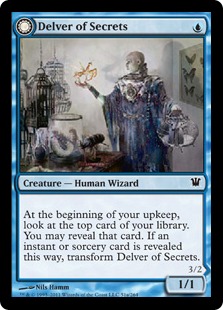 Given its colors and many similar cards, I can't say for sure that Ninjutzoo isn't a worse version of Counter-Cat. I will say that Counter-Cat is almost certainly a better deck. Whether Ninjutzoo has anything over it remains to be seen.
Given its colors and many similar cards, I can't say for sure that Ninjutzoo isn't a worse version of Counter-Cat. I will say that Counter-Cat is almost certainly a better deck. Whether Ninjutzoo has anything over it remains to be seen.
In any case, I can't wait to bring this baby to my shiny new Boston locals. Few feelings are as gratifying as winning with your pet cards. I must sound like a broken record by now in my unending praise of the format, but that's what I love most about Modern—if we account for metagame parameters, creature playability requirements, and the ol' Bolt Test, much more is possible than meets the Top 8 database.






Dear god, finally something for me to do with my foil Ninja of the Deep Hours!!
Cannot wait!
I proudly piloted blue-red ninjas to a 1-6 finish at the SCG open in NJ this past August. Ninja of the deep hours is my all time favorite card.
Congrats on the strong finish!
The first rule of ninjitsu is to play evasive one drops with additional value, I highly suggest trying mausoleum wanderer and judges familiar. Flying is a big deal, it is on color, and it is only a little slower.
It’s actually a LOT slower! Familiar will never close games on his own, which means it has the same problem as Spellstutter Sprite. Our threats need to actually work without Ninjas hanging around. JFam also doesn’t grow past a Bolt before blockers are declared, which keeps us from ever even using ninjutsu against smarter opponents.
It warms my heart to see more Deep Hours enthusiasts. The look on my opponents’ faces so far when I draw multiple cards off the guy is priceless.
A couple of new updates and insights to the deck for those looking to pick it up:
1. I fixed the manabase. It was unwise to have two “dead” lands (Hallowed Fountain and Island) in the deck. When I fetched them, they would often sit around doing nothing for a few turns. The Pool-Foundry drawback of not allowing us to save a turn one Cat only comes up when we have Cat and Growth and lands that ask us to fetch that pair AND when opponents have a Bolt, so I don’t think it’s that relevant after all. Pool-Foundry is a great pair for the deck and supplementing them with a Stomping Ground makes our mana superb for the game.
It should be noted that access to Island becomes very important once we make our third or fourth land-drop. Having a third basic to fetch out painlessly to help cast colorless-requiring spells like Goyf and Ninja is a godsend when we want to use our properly-colored lands on Bolts, Gnarlwoods, etc.
The only reason Tarns are still in this manabase is that they allow us to easily grab Island when we expect Blood Moon. Here’s what our fetches can grab, which is important to keep in mind as lands get fetched out of the deck and the value of our fetches fluctuates accordingly:
foothills – everything but ISLAND
misty – everything but FOUNDRY, MOUNTAIN
tarn – everything but TEMPLE, FOREST
New manabase:
4 Foothills
4 Misty
2 Tarn
1 Steam Vents
1 Temple Garden
1 Breeding Pool
1 Sacred Foundry
1 Stomping Ground
1 Island
1 Forest
1 Mountain
2. It seems after some testing that Ninja is a worse Snapcaster in this deck. It would almost certainly improve with some small tweaks and by dumping one for the other. Three mana on Ninja to draw a blind card is definitely worse than three mana on Snap-Bolt or Snap-Path, especially since Snapcaster can be cast at any time, including during an opponent’s turn, and Ninja has a very specific window. But if Ninja is able to connect TWICE OR MORE, he’s exceeded Snapcaster in value and it becomes difficult for opponents to win. I just don’t think that’s enough of a reason, from a competitive standpoint, to favor Ninjas.
Of course, I didn’t build this deck from a purely competitive standpoint. My goal was to play Ninjas, so I’m keeping them in the list. Ninja is also better early on; Swiftspear into Ninja, followed by Growth for protection, is game-winning against Bolt decks. Since Swiftspear has haste, we can even cast her again on turn three and immediately tag her out for a second Ninja!
Im apalled that you went for mutagenic instead of disrupting shoal (or both)! Notdh is like tailor made for shoal – it protects ninja while ninja draws fuel to make up the card loss. I would have tried judges familiar and mausoleum wanderer as enablers. I used jfam instead of phantasmal bear in the ninjabeardelver and always preferred it. Wanderer gives you 8 paths to t2 ninja and mutagenic w wanderer is kind of four more disrupting shoals. Birds of paradise could work too – add a sword or rancor and now we’re brewing! (would love a cheap ug creature that you sac to draw equal to power for this kind of deck!)
As is this looks like a normal zoo deck with four bad cards shoehorned in. Barely resonates as a “brew”.
I actually tried a few builds with Ninja before the ones in this article, and have been experimenting with him for over a year! My starting point was Faeries, and I did give evasive, disruptive one-drops a go including JFam). The problem with all of these creatures is that they didn’t apply pressure or end games on their own. Even exalted from Hierarch didn’t solve the problem. I needed one-drops that could actually kill opponents when left to their own devices.
It also doesn’t help that JFam & co. can be Bolted even through a Mutagenic Growth. Once opponents know what we’re up to, they can just remove our threats before we proceed to the blockers step and prevent us from ever having a window to use ninjutsu.
The few creatures that fit my specific criteria (Gnarlwood, Nacatl, Swiftspear) happen to not be blue, which bars us from using Shoal as a protection method. There also aren’t that many 4-drops to Shoal in Modern any more, since many Abzan decks are transitioning away from Rhino and towards Flayer, and Twin is gone. These factors make Muta a more flexible protection method anyway, esp. since it helps us win combat or push through damage with Nacatl and our other beaters.
Finally, I know it’s a Zoo deck with four bad cards shoehorned in. But the conclusion I’ve come to is this is the most competitive build of a deck at the moment that includes Ninja of the Deep Hours. As explained above, getting “brewier” with stuff like Judge’s Familiar would just make the deck a lot worse. IMO “brew” doesn’t necessitate “worse version of another deck”—in fact, decks that do that violate rule #1 of brewing!
Ninjutzoo might be a worse Delirium Zoo (or a worse something else), but I’m afraid any deck with Ninja of the Deep Hours is already guaranteed to be a worse version of another deck since there are so many better creatures available to attacking strategies in Modern. That said, if you want to propose/test/tweak a different list running 4x Ninja of the Deep Hours I’d be happy to check it out.
So, what do you think about replacing Gnarlwood, Spear, and some Growths, for playsets of Familiar, Wanderer, and Shoal?
Answered this yesterday, scroll up!
I wish I could come here more brews then temurgoyf.dek I like everything else about this place but seeing the same deck rehashed over and over again is pushing me away.
Jordan love his UR Goyf decks. I think Goyf supports the disruption from with a quick clock too well.
Would love to see a straight UR attempt with Thing in the Ice though! There’s another card with enough power to support interaction!
My beef with Thing is that it’s a terrible topdeck. Decks like Jund want to get you into a top-of-your-deck scenario, and in those cases, Thing is a wasted draw (what does it do, chump Tarmogoyf?). On the other hand, Goyf is always going to be good. Early on, it’s the only 2CMC or less combat creature that inherently resists Lightning Bolt, and later in the game it can dwarf Reality Smasher without much effort. Plus, it always costs two, giving late-game pilots a chance to attack with Raging Ravine or do something else with their mana in addition to casting the Goyf!
I think Thing’s a good card, but it fits better into combo-oriented shells that can flip it with great frequency (Jeskai Pyromancer Ascension, UR Prowess, etc.) than it does into goodstuff grow decks. Grow needs highly versatile cards that are good at all stages of the game to function (i.e. Bolt, Goyf), so Thing is a lot worse in those decks.
Additionally, in the aggro decks I brew with Tarmogoyf, Goyf often performs a very specific role—cleaning up after my Bolted one-drops. This is just one of Goyf’s many unique applications in Modern and a good example of something Thing can never do.
Temur is an under-played (and under appreciated) color combination n Modern. I look forward to these articles all the time.